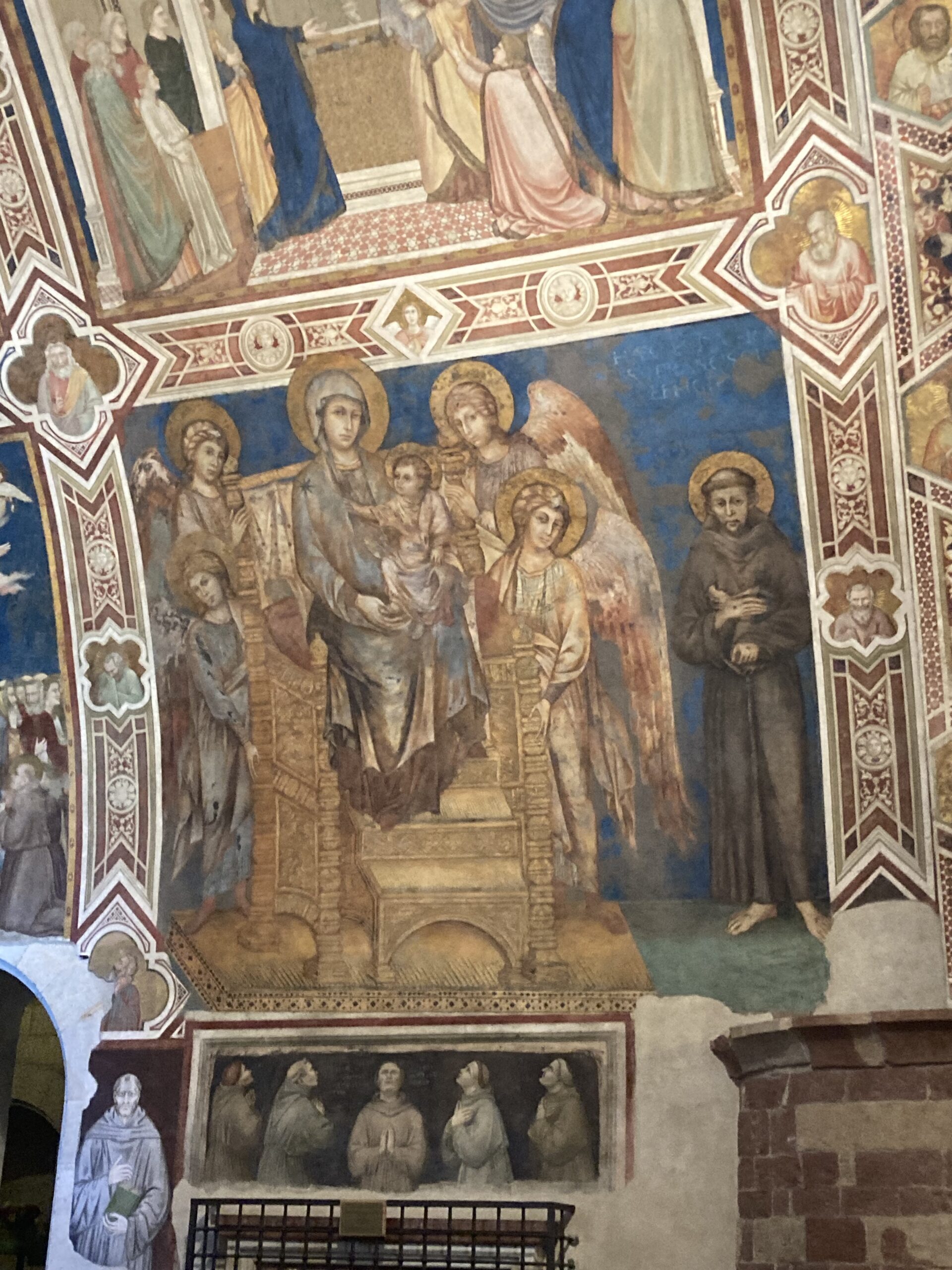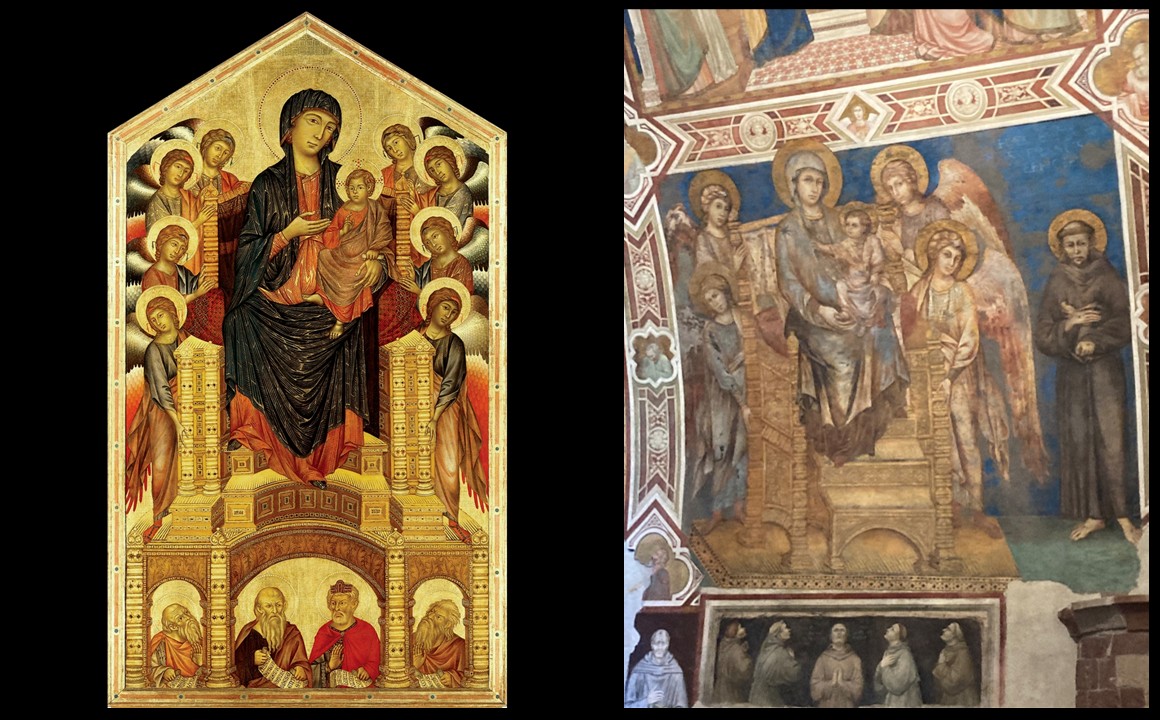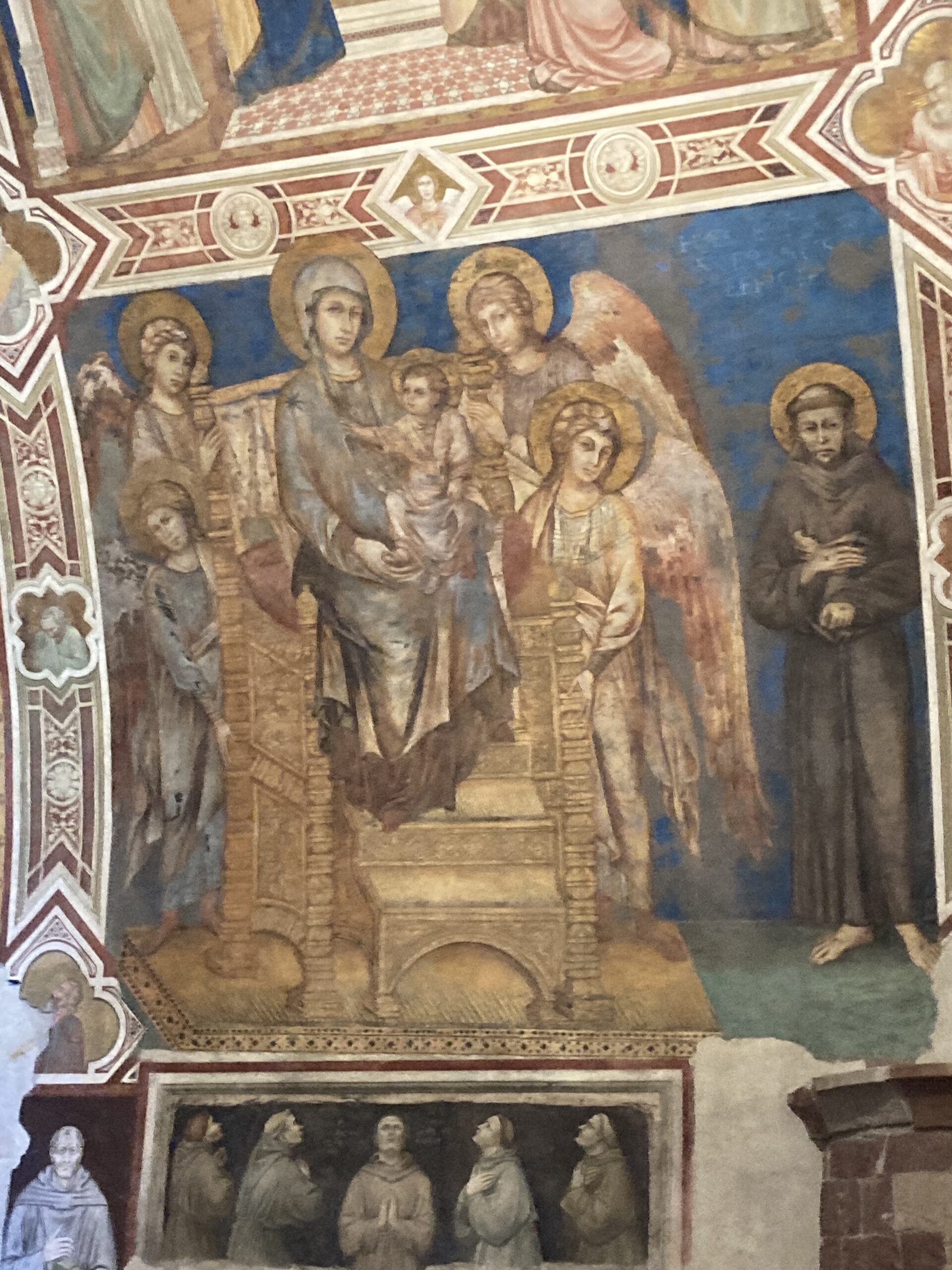
Maestà di Assisi, 1285-1288, fresco, 320×340 cm, Basilica of San Francesco in Assisi, Italy – Photo Credit: Amalia Spiliakou, April 2025
When I visited the Lower Church of San Francesco in Assisi in April 2025, I was struck by the quiet majesty of Cimabue’s Maestà di Assisi. Tucked into the dimly lit transept, this fresco radiates a sense of reverence and timelessness that photographs simply can’t capture. Seeing the Virgin Mary enthroned with the Christ Child, surrounded by a chorus of angels, I was moved by how Cimabue bridged the distance between the divine and the human. Painted around 1285, this work marks a crucial shift from the rigid, symbolic forms of Byzantine tradition toward a more naturalistic and emotionally resonant style. The delicate modeling of faces, the subtle sense of depth, and the quiet dignity of the figures all hinted at the artistic revolution that would soon follow. In this post, I’ll reflect on how Cimabue’s Maestà not only embodies the spiritual vision of its time but also left a lasting impression on me as a viewer, and on the course of Western art.
Cimabue’s Maestà di Assisi is in the south transept of the Lower Church of the Basilica of San Francesco in Assisi, a site of profound spiritual and artistic significance. The Basilica, constructed in the 13th century to honor Saint Francis, consists of two levels: the soaring Gothic Upper Church and the more intimate, Romanesque Lower Church. Within this dim, contemplative space, the Maestà forms part of a rich fresco program that includes scenes from the lives of the Virgin and Saint Francis, as well as works by other major artists of the period, including Giotto, Pietro Cavallini, and Simone Martini. Together, these masterpieces transform the Lower Church into a visual pilgrimage through the early stages of Italian art, where Cimabue’s contributions mark a critical bridge between the Byzantine tradition and the emerging naturalism of the Renaissance.

The Madonna in Majesty, 1285-86, tempera on panel, 385 x 223 cm, Uffizi Gallery, Florence, Italy
Maestà di Assisi, 1285-1288, fresco, 320×340 cm, Basilica of San Francesco in Assisi, Italy – Photo Credit: Amalia Spiliakou, April 2025
Cimabue, born Cenni di Pepo around 1240 in Florence, is widely regarded as one of the pivotal figures in the evolution of Western art. He was trained in the Byzantine tradition, which dominated Italian painting in the 13th century with its stylized forms and gold backgrounds, but Cimabue began to break from these conventions in subtle yet significant ways. Active mainly in Florence and later in Assisi, he worked on both panel paintings and large-scale fresco cycles. His most famous surviving works include the Santa Trinita Maestà (Uffizi Gallery), the Crucifix at Santa Croce, and his contributions to the decoration of the Basilica of San Francesco in Assisi. Cimabue was also the teacher of Giotto, whose revolutionary approach to realism would carry forward and amplify the artistic shift that Cimabue had initiated. Although his style remained rooted in medieval spirituality, Cimabue laid the groundwork for the expressive potential and spatial complexity that would define early Renaissance art.
Cimabue’s work is characterized by a remarkable tension between Byzantine rigidity and the early stirrings of naturalism. In his Assisi frescoes, particularly the Maestà in the Lower Church, he introduces a greater sense of depth and volume through delicate shading and a more thoughtful use of space. The figures, while still hieratic and front-facing, possess a dignity and gravitas that suggest a growing concern with human presence and emotional resonance. The Maestà di Assisi exemplifies this transition: the Virgin sits enthroned in a symmetrical, richly colored composition that respects traditional iconography, but the softened contours of her face and the more varied, overlapping arrangement of the angels begin to imply a spatial realism that was new for its time. Cimabue’s aesthetic choices reflect both reverence for sacred themes and a quiet but revolutionary move toward a more lifelike visual language—one that would deeply influence the course of Italian art.

Maestà di Assisi, 1285-1288, fresco, 320×340 cm, Basilica of San Francesco in Assisi, Italy – Photo Credit: Amalia Spiliakou, April 2025
In Cimabue’s Maestà di Assisi, Saint Francis is represented standing to the right of the throne, distinguishable by his simple friar’s habit, bare feet, and the visible stigmata on his hands, feet, and chest—a gesture of his deep union with Christ’s suffering. According to tradition the image of the saint is based on eyewitness descriptions by those who knew him personally and is considered one of the earliest and most authentic portrayals of Francis. The fresco originally included other figures, possibly Saint Anthony of Padua, on the left side, but that section is now lost, suggesting that the original composition once conveyed a broader devotional context. The contrast between the elevated, richly dressed figures of the Virgin and Child and the humble, sober figure of Francis reinforces the spiritual ideals of Franciscan humility and poverty. The recent restoration, completed in early 2024, which removed centuries of overpainting and yellowed protective layers, has revived the sharpness of Francis’s face and refined features, attributes described in medieval sources, allowing viewers today to reconnect more directly with Cimabue’s original vision and the powerful symbolism of the Poverello himself.
For a Student Activity titled Compare and Contrast Activity: Cimabue’s Two Maestà, please… Check HERE!
Bibliography: https://www.lavoce.it/assisi-presentato-il-restauro-che-svela-il-vero-volto-di-san-francesco/?utm_source=chatgpt.com and https://en.wikipedia.org/wiki/Cimabue?utm_source=chatgpt.com and https://www.assisinews.it/speciali/svelata-la-maesta-di-assisi-restituita-allaffresco-la-vera-materia-del-cimabue-foto/?utm_source=chatgpt.com and https://www.lanazione.it/cosa-fare/il-capolavoro-di-cimabue-gloria-alla-maesta-di-assisi-sublime-luce-al-restauro-8aaee18e?utm_source=chatgpt.com